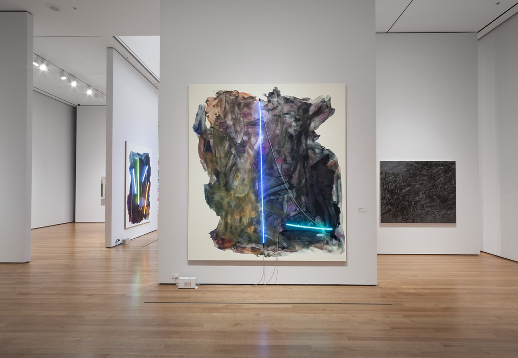Earlier I wrote about the Painting 2.0 exhibition at the Museum Brandhorst in Hamburg. It occurred to me after the fact that this is third of several exhibitions this past year that were threaded on a similar thematic thread. Add to the previous the American exhibitions The Forever Now: Contemporary Painting in an Atemporal World, mounted by the Museum of Modern Art last winter; and the roughly concurrent Variations: Conversations in and Around Abstract Painting, hosted by the LACMA. The latter received almost no attention, while the former prompted a great many reviews, almost all of them harshly negative. The Brooklyn Rail recently featured a lengthy comparison of the two shows, aiming to to account the disparate strengths and weaknesses of each show, as well as what sort of thesis they might present about the plight of contemporary painting:
"Is the supposed crisis in painting a product of the medium’s own neurosis? Perhaps it isn't that painting is dead but that, like many of us, it suffers from anxiety about death? Maybe painting is depressed, a sentiment I dare say many critics would validate; or narcissistic (undeniably), or irrationally obsessed with the threat of other mediums. Obsession of some sort seems the most likely diagnosis, with the result being compulsive inward-looking as well as an unhealthy fixation on what painting or sculpture or video might be doing."
Not bad for a start. But unfortunately after that point the article begins chasing its own tail, the author defaulting to half-century-long about formalism vs anti-formalism polemics, via the dusty grad-school required-reading of Clement Greenberg's "Towards a Newer Laocoön" and Rosalind Krauss's "Sculpture in the Expanded Field." Which only raises the questions: If painting is reputedly dead or in crisis, why is it still a matter of discussion a half-century after being declared so? Why haven't the parameters of the discourse shifted, or the critical vocabulary significantly revised, in the interim decades since?
Of the many reviews of MoMA's The Forever Now exhibition, perhaps the most interesting I’ve come across is the one penned by (surprisingly enough) the artist David Salle, which appeared in the pages of ARTnews. As one would expect, Salle has skin in the game, and critiques the show in largely pictoral terms. Salle waves off all the agonistic concerns about the fate of painting in the digital ago, concluding:
"...The [exhibition’s] good news, is that painting didn't die. The argument that tried to make painting obsolete was always a category mistake; that historically determinist line has itself expired, and painting is doing just fine. Painting may no longer be dominant, but that has had, if anything, a salutary effect: not everyone can paint, or needs to. While art audiences have gone their distracted way, painting, like a truffle growing under cover of leaves, has developed flavors both rich and deep, though perhaps not for everyone. Not having to spend so much energy defending one's decision to paint has given painters the freedom to think about what painting can be. For those who make paintings, or who find in them a compass point, this is a time of enormous vitality."
This, after having established in early in the review:
"[Curator Laura Hoptman] wants to make a point about painting in the Internet age, but the conceit is a red herring — the Web's frenetic sprawl is opposite to the type of focus required to make a painting, or, for that matter, to look at one."
Also of interest was Salle's takedown of the work of recent art-market sensation Oscar Murillo. In which Salle focuses on Murillo's work in strictly pictorial and presentational terms, tactfully sidestepping the sorts of spleen-venting scattershot screeds Murillo has received (however deservedly) from other critics.
Which brings us to another, closely related, topic. All of the above having transpired in the context of a parallel discussion about the ascent of "Zombie Formalism" -- the glut of painting-qua-painting as produced by a number of contemporary and emerging artists, artists who've been hot on the art market in recent years (and a number of whom are included in the aforementioned exhibitions).* While I don't wholly disagree that there's been a lot of slight, anemic, vaguely homogenized style of painting in recent years. But personally, I'm not sure my the category of painting has borne the brunt of the criticism. As the art market bubble has expanded in recent years, I'm inclined to argue that all that money pouring into the market in search of "mobile assets" to chase has had a diminishing effect across the disciplinary spectrum; resulting in a deluge monotonously generic work in all of the more dominant categories, as well -- from video, to installation and multimedia works, you name it.
* For the unfamiliar, examples here and here. As well as the ur-text that got the whole ball rolling.



No comments:
Post a Comment